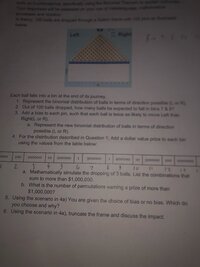You are using an out of date browser. It may not display this or other websites correctly.
You should upgrade or use an alternative browser.
You should upgrade or use an alternative browser.
Urgent help on binomial distribution Q
- Thread starter Xibu4
- Start date
Steven G
Elite Member
- Joined
- Dec 30, 2014
- Messages
- 14,561
Do you see that when the marble goes from one row to the next it hits a peg when it reaches that new row? Now the marble can only go left or right before it goes to the next row, then hit the peg and go left or right....
To have a ball land in say position 9 there a specific number of lefts (L) & rights (R) the marble with travel through.
Convince yourself that to get to any position at the bottom (say position 9) it will take a specific number of L and R to get to that position and only to that position. This is important!
In how many ways can the marble travel from to bottom? At each row there is a decision to make (left or right). So how many different outcomes are there? Call this number A.
Now say to get to position 9 you need 4L's and 5R's (by no means am I saying that is correct). In how many ways can you write 4L's and 5R's? I told you how to calculate this in your previous post. Call this number B.
Now we now P(the ball lands in position 9) = B/A.
You need to calculate A. Then you need to calculate the B value for all possible positions the ball can land in.
I gave you the complete recipe to do this problem. If any step is unclear, then post back stating what the problem is.
To have a ball land in say position 9 there a specific number of lefts (L) & rights (R) the marble with travel through.
Convince yourself that to get to any position at the bottom (say position 9) it will take a specific number of L and R to get to that position and only to that position. This is important!
In how many ways can the marble travel from to bottom? At each row there is a decision to make (left or right). So how many different outcomes are there? Call this number A.
Now say to get to position 9 you need 4L's and 5R's (by no means am I saying that is correct). In how many ways can you write 4L's and 5R's? I told you how to calculate this in your previous post. Call this number B.
Now we now P(the ball lands in position 9) = B/A.
You need to calculate A. Then you need to calculate the B value for all possible positions the ball can land in.
I gave you the complete recipe to do this problem. If any step is unclear, then post back stating what the problem is.
Dr.Peterson
Elite Member
- Joined
- Nov 12, 2017
- Messages
- 16,619
You are asking for help on #4 this time, right?Can anybody please help me with question 4. The cut off bin values are bin 0 = $1 and bin 14=$1.
Any advice would be appreciated, thank you.
View attachment 34571
What does it mean, in your class, to "mathematically simulate the dropping of 3 balls"? To me, a simulation would be done with a computer; I wouldn't expect that to mean calculating a probability, but you'll have to decide what it means.
Then they say to list combinations; possibly this is what they mean by "simulation", though it doesn't involve probability as I would expect. What sets of 3 balls would result in a total of more than 1,000,000? For example, one would be bins 0, 6, and 13: $1+$1+$1,000,000=$1,000,002.
I have to say, the problem is not very clearly written, unless you had examples just like it in class that clarify what is meant.

